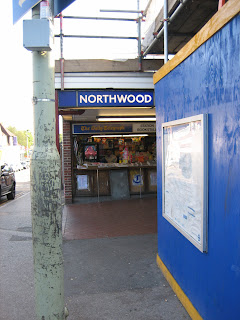One route spirals towards Uxbridge; the other strikes out for Hertfordshire and, ultimately, Buckinghamshire. I was now travelling through a part of the Underground network that had always, by virtue of its distance from the city centre, seemed to me to have an air of otherworldliness.
What were all those stations doing so far from central London, in travelcard zones that were so remote they needed not numbers but letters? Why did the line have so many branches and peculiar offshoots? What kind of tiny places were these, joined artificially to the likes of the swaggering Baker Street and Kings Cross?
Rattling towards the Hertfordshire border in a carriage of ever-diminishing passengers, the first stop is North Harrow. There's a tangible difference in the air between this station and its predecessor, effectively summed up by the way there's a door out of the booking hall directly into a coffee shop. There's also a wonderfully parochial shop next door (Soles And Heels), which is part-ironmonger, part-shoemaker, and which looks like it's been there for 60 years.
When the Metropolitan first passed this way in 1885, there was no reason for trains to stop here because - as with other stations further down the line - there was nothing to stop for. It wasn't until 1915 that passengers could get on and off, presumably to have a cup of tea or a get a key cut.
A feeling of staid, unruffled suburbia intensifies at Pinner.

The trains did stop here as early as 1885, but only to attend to folk dwelling in the tiny village and surrounding farmland. The very name Pinner seems to embody a certain, well, frame of mind or attitude to life. It's a place where cosy primetime sitcoms take place. It's a place from where people write letters to broadsheet newspapers. It's a place where people settle, rather than simply somewhere to live. This is the view from the station bridge back towards Harrow (the church spire is on the horizon):
Northwood Hills didn't open until 1933. The titular greenery can be seen in the distance, disclosing the fact that the area isn't actually on a hill at all. There were two old women waiting by this entrance, watching me with piqued curiosity and discussing - inevitably - the weather.
Northwood station, meanwhile, is another of the 1887 vintage and currently covered in scaffolding. When I was there it was also full of schoolkids on their way home, eyeing me suspiciously. This bloke, though, didn't seem to care what I was doing.
Pulling into Moor Park you're finally out of Greater London, into Hertfordshire and more or less on a regional branch line rather than an urban public transport system.
It's a lovely station, reeking of days gone by, full of brown colours and old oak panelling, and originally built purely to serve patrons of the local golf club. Indeed, its original name was Sandy Lodge. Standing on its platforms, surrounded by trees on all sides, a few buildings in the distance, peace and quiet everywhere, it's possible to believe you're hundreds of miles away from London and fully ready to hear the sound of a steam engine in the distance.
But this still isn't the end of the Metropolitan line.





No comments:
Post a Comment